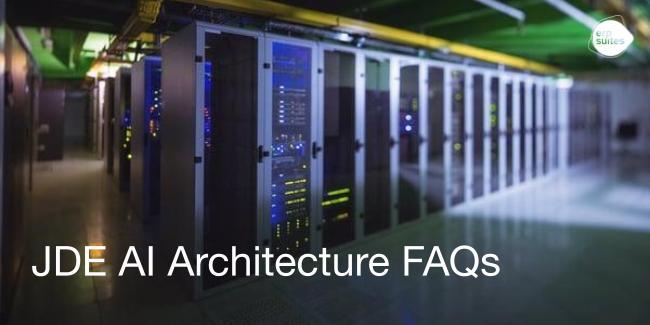From Frustration to Automation: Winning with JDE Orchestrator
June 9th, 2025
3 min read
In this episode of "Not Your Grandpa's JD Edwards," Nate Bushfield speaks with Mo Shujaat, VP of Advisory and Consulting Services at ERP Suites, about optimizing JD Edwards through strategic process automation. Mo shares valuable insights into identifying high-impact automation opportunities, qualifying use cases for ROI, and effectively leveraging JD Edwards Orchestrator. He highlights real-world scenarios demonstrating how intelligent orchestration can dramatically improve user productivity, reduce manual work, and streamline critical business processes. By the end of the episode, IT leaders and JD Edwards users alike will gain clarity on how to implement automations that truly move the needle.
Table of Contents
-
Introduction: The Frustration with Manual Processes
-
Identifying Automation Opportunities
-
Engaging Users to Discover Bottlenecks
-
Qualifying Automation Use Cases for ROI
-
Avoiding Common Automation Pitfalls
-
Real-World Orchestration Success Stories
-
Replacing Traditional UBE Data Selections
-
Next Steps: Bringing Automation to Your Business
Transcript
Introduction: The Frustration with Manual Processes
Are your JD Edwards users still bogged down by repetitive manual processes? What if there was a way to automate those clicks, eliminate tickets, and start making AI-powered decisions inside JD?
Today, in this episode of "Not Your Grandpa's JD Edwards," I sit down with Mo Shoe Shot to explore how to identify the best automation opportunities, qualify them for ROI, and unlock serious value using orchestrator. Stick around, this one's going to change how you think about process automation.
Hello everyone, and welcome to "Not Your Grandpa's JD Edwards," the podcast where we explore practical ways to bring JD Edwards into the future. I'm your host Nate Bushfield, and today I'm excited to be joined by Mo Shoe Shot, VP of Advisory and Consulting Services at ERP Suites.
Mo, how are you doing today?
I'm doing really well, Nate. I'm excited to talk automation, orchestrations, and some cool stuff with you.
Identifying Automation Opportunities
Why do so many JD Edwards users feel stuck doing manual, repetitive tasks in 2025?
It's because they're still doing manual, repetitive tasks in 2025! Users are used to instant, automated experiences in their daily lives through technology, social media, and apps. When they get to work, they're frustrated by systems that force them to manually search for critical business information, resulting in unnecessary delays and productivity losses. But with JD Edwards Orchestrator, we can finally address these pain points.
Engaging Users to Discover Bottlenecks
What type of signals should organizations look for to identify automation opportunities?
Look for pain, frustration, and lagging processes within your business. For example, lengthy item master entry processes that involve multiple clicks can be automated using orchestrations. If a process seems unnecessarily long, investigate further—you'll likely find opportunities for automation there.
How can IT leaders surface these inefficiencies?
Build coalitions and relationships with your business counterparts. Form committees or Centers of Excellence, bring people together regularly, and actively brainstorm automation opportunities. Strong collaboration between IT and business units will help identify meaningful improvements.
Qualifying Automation Use Cases for ROI
How do companies know which automation use cases are worth pursuing?
Use financial modeling and ROI analysis. Automation opportunities generally fall into three buckets:
-
No-brainers: Simple, high-impact improvements like replacing repetitive data selection screens with orchestrations.
-
High-value automations: Clear business cases that require deeper analysis, possibly involving vendors or consultants to prove ROI.
-
Low-value opportunities: Recognize when the effort to automate outweighs benefits and be strategic about where to focus your resources.
Avoiding Common Automation Pitfalls
What pitfalls do companies run into when automating processes?
Design and architecture mistakes. Poorly designed orchestrations can create more problems, causing crashes or data issues. Always carefully consider workflow, data quality, and redundancy. Also, seek input from peers or partners to validate your orchestration designs.
Real-World Orchestration Success Stories
Can you share examples of high-impact orchestrations companies are using today?
Yes, orchestrations have been game-changers:
-
Error-handling orchestration: Automatically creates a service desk ticket when an integration fails, proactively resolving issues before users notice.
-
Complex configurator orchestration: Successfully automated configured sales orders, overcoming perceived limitations with orchestrations and JD Edwards.
These examples demonstrate orchestrations’ ability to streamline complex tasks and ensure reliable, intelligent outcomes.
Replacing Traditional UBE Data Selections
You often say "Read my lips, no more data selection." How does orchestration replace traditional UBE data selection screens, and what does it do for end users?
This approach removes unnecessary clicks and simplifies user experience. Instead of manually selecting data each time, orchestrations automate these repetitive tasks, instantly generating required outputs (like reports or PDFs) with minimal interaction. It significantly improves quality-of-life and reduces user frustration, creating a more elegant, streamlined JD Edwards experience.
Next Steps: Bringing Automation to Your Business
If you're hearing this and thinking your business needs these orchestrations yesterday, don't wait. Visit ERPsuites.com or connect with Mo and the team. Whether it's quick orchestration wins or planning your AI readiness roadmap, ERP Suites can help you prioritize and deliver real value.
That's a wrap. Huge thanks again, Mo. If you liked what you heard, subscribe, leave a review, and share this with a colleague who’s tired of manual processes.
Until next time, keep automating, keep modernizing, and keep pushing JDE forward. Catch you later.
Video Strategist at ERP Suites
Topics:


